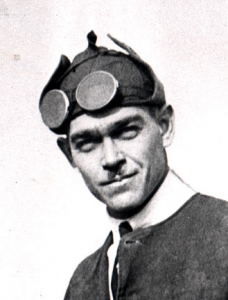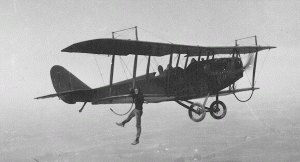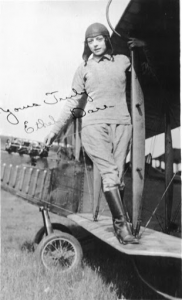
Wingwalking History
 Wingwalking initially arose out of practicality, Pilots would often need to venture onto the Wings of their planes in flight in order to make technical adjustments and fix broken parts.
Wingwalking initially arose out of practicality, Pilots would often need to venture onto the Wings of their planes in flight in order to make technical adjustments and fix broken parts.
The earliest documented case of Wingwalking was as early as 1911, but it was Army Pilot Ormer Locklear who first saw the potential commercial appeal of Wingwalking.
On November 8, 1918, Locklear wowed the crowd at Barron Field, Texas, with his daredevil wing-walking stunts. Wingwalking was seen as an extreme form of Barnstorming, and Wingwalkers would constantly take up the challenge of outdoing one another at these so-called Flying Circuses and with the end of the First World War Aircraft were in plentiful supply and cheap to buy. Locklear also took his skills to the glitz and glamour of Hollywood where he worked with greats like Cecil B. de Mille (The Great Air Robbery).
Locklears female equivalent and the first woman to switch planes in the air was the aptly named Ethel Dare. One of Dares most famous stunts was the “Iron Jaw Spin” during which she would suspend herself by rope with a special mouthpiece, and twirl non stop in the planes propwash!
The fact that Dare along with other Women were so heavily involved in such a spectacle at a time when they didn’t even have the right to vote was both remarkable and liberating.
Throughout the 1920s, Flying Circuses travelled around America spreading the news of aviation, “looping the loop”, parachute jumping, Wingwalking and taking bystanders who wanted to be part of the action for exhilarating flights – The first form of commercial aviation!
On arrival in an area Pilots would fly low over villages in order to get peoples attention and attract a crowd. Over time their stunts would get progressively more daring as they sought to attract paying customers and hold everyone’s attention, Stunts included mid-air handstands, target shooting and even games of tennis, most of which were performed without any kind of safety harness or cables! After the end of a long day barn storming Pilots would often then spend the night in the Farmers Barn – Hence the name “Barn Storming”
Eventually, in 1936 the Flying Circuses were banned by the American government who were keen to promote commercial transport flying and considered the Flying Circuses to be too dare-devil.



Then in the 1950s Wingwalking started again in the USA, mostly on Boeing Stearman Bi-Planes which were considered much safer and stronger than other the early Pre-War Bi-Planes.
In 1962 the UK the Tiger Club, who were at the time based in Redhill, Surrey, fitted a Rig to a Tiger Moth and a little later the “Barnstormers” in Northamptonshire followed suit.
Finally in the late 1980s Boeing Stearman Bi-planes, the first to be fitted with a Wingwalking rig, arrived in the UK most famously sponsored by Cadburys, Utterly Butterly, Breitling and Guinot.
And now Wingwalk.Buzz invites YOU to become a part of the modern History of Wingwalking by participating in your very own Wingwalking Experience with our expert Pilots.
